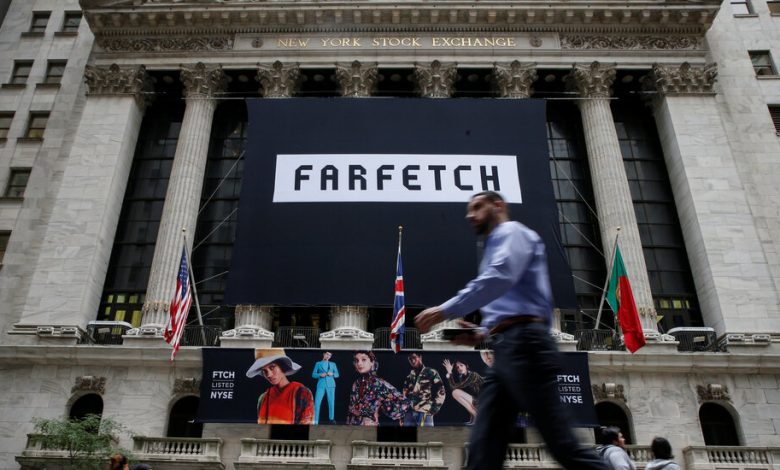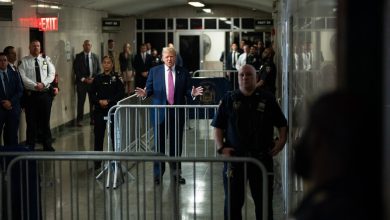Is Luxury’s Favorite E-Tailer About to Go Bust?

For more than a decade, Farfetch has been a global retail powerhouse, selling billions of dollars worth of coats, shoes, handbags and other luxury goods.
But in recent months, the online platform, which was valued at more than $20 billion at its peak in 2021, has been fighting for its survival. Its share price has collapsed, rumors have been swirling that its founder is trying to take the company private and reports suggest it will need a lifeline of at least $500 million by the end of the year to prevent it from toppling into bankruptcy.
Farfetch has multiple big-name investors, including Alibaba, the Chinese tech giant; Artemis, the holding company of the billionaire Pinault family, which owns Kering; and Richemont, the Swiss luxury group. The company’s shares lost about a third of their value this week, at one point dropping to a record low of just 60 cents, giving the firm a market value of around $250 million.
Farfetch declined to comment for this article.
How did Farfetch fall so far and so fast? Who might be able to step in and save it? And who will be affected if it collapses?
What is Farfetch?
Farfetch came to life in 2007 as an e-commerce marketplace for brick-and-mortar fashion boutiques. This meant that a shopper in London could buy boots from an independent shop in Paris, or a customer in Beijing could source a bag that wasn’t available locally from a store almost 5,000 miles away in Venice. Today, it works with more than 550 fashion boutiques in 190 countries.
As consumer appetite for buying luxury goods online began to grow, the company also started working directly with fashion brands to build their websites and back-end operations. Through Farfetch Platform Solutions, the company now offers a host of e-commerce services to brands, like Burberry and Ferragamo, and department stores, like Harrods and Bergdorf Goodman.
In 2015, it bought Browns, the London fashion boutique, and in 2018, the company, then described as “the Amazon of fashion,” went public on the New York Stock Exchange.
Who founded it?
José Neves, 49, is a Portuguese entrepreneur whose first foray into the fashion business came in 1996 with a shoe brand called Swear. For years, he was seen by the fashion industry as a game-changing guru who could guide brands toward successful digital strategies — and accumulated an estimated $2.5 billion personal fortune as a result.
Farfetch is a public company, but Mr. Neves still owns a 15 percent stake and 77 percent of the voting rights through a dual-class share structure.
Does the company make money?
Farfetch charges a cut of more than 30 percent of sales for making a retailer’s stock available to almost a million active customers. The company reached profitability for the first time in 2021 but has had a rocky time maintaining it since then.
When did things start to go wrong?
The luxury retailer’s appetite for risk started to become apparent in 2019, when more than $2 billion was wiped off its market value in a single day after it blindsided investors with a $675 million takeover of the Italian holding company New Guards Group, owner of the license for the fashion label Off White and brands like Palm Angels, and reported larger than expected losses.
Mr. Neves defended the acquisition, saying that Farfetch was still in growth mode, but critics felt it was an expensive deviation from Farfetch’s original inventory-free, logistics-focused strategy. It also owns a $200 million stake in the American department store Neiman Marcus.
Even still, several of fashion’s major power players kept the faith. Alibaba and Richemont backed Farfetch through a complex tie-up in which they invested $300 million each in the company, and another $250 million each for a 25 percent stake in its Chinese offshoot. Its market value peaked at $23 billion in early 2021 as luxury shopping boomed in the pandemic.
Since then, there have been major headaches. Overhead costs soared as the company continued to scale up. This year, in Farfetch’s second-quarter results, the New Guards division posted a 40 percent drop in sales, despite a much celebrated partnership with Reebok that was unveiled earlier in the year. Farfetch also reported $1.15 billion in debt for its fiscal quarter ending in June.
There have been seismic shifts in the wider fashion landscape as well. Many larger brands are pushing for more control over their e-commerce and distribution operations, partly to avoid discounts by third-party partners like Farfetch. There has also been a slowdown in the global luxury market, especially in key markets like the United States and China.
What happened recently to make it even worse?
Last month, investor confidence was shattered after Farfetch said it was postponing the release of its latest quarterly results, saying it would “not be providing any forecasts or guidance at this time, and any prior forecasts or guidance should no longer be relied upon.”
The announcement sent Farfetch’s shares tumbling, and this week, two years after Farfetch’s peak valuation, its market value shrunk to less than $238 million, with its shares losing more than 97 percent of their value since its initial public offering.
A complex deal announced in August 2022, in which Farfetch planned to buy a 47.5 percent stake in Yoox Net-a-Porter, its rival at Richemont, is likely to be renegotiated given the crisis enveloping Farfetch. The deal could even collapse.
Can its problems be solved?
Mr. Neves has been taking steps to improve the company’s fortunes. This year, Farfetch closed its beauty business and laid off 11 percent of its employees as part of what Mr. Neves described in an earnings call as the most significant cost-cutting measures in the history of the company. There is also industry chatter that he is looking to sell Browns and the beauty retailer Violet Grey.
But the share price has continued to plummet, and major investors like Richemont have said they won’t be providing fresh capital. This month, J. Michael Evans, the Alibaba president, stepped down from Farfetch’s board.
Now the British business media reports that Mr. Neves is seeking a white knight investor to help take the company private again. Those reportedly in talks with Farfetch include Apollo Management and an original private investor, Carmen Busquets.
The company is also facing lawsuits, with law firms encouraging investors to sue Farfetch for providing what they say is misleading information to shareholders about the state of its business.
What happens if they aren’t solved?
The company will be forced to file for bankruptcy protection or be liquidated.
Why does it matter?
Whether Farfetch survives could affect how consumers shop for fashion. This is because of the number of big-name brands it counts as e-commerce clients — though most of them could probably turn to a rival. That switch would be more complex for the 700 smaller boutiques and thousands of independent designers who rely on Farfetch. Consumers have become comfortable making luxury purchases at the click of a button. Other players exist in the space. But if Farfetch is not around to enable many of those sales, the digital experience of luxury shopping could change significantly as brands and sellers scramble to find a new way of doing business online.




